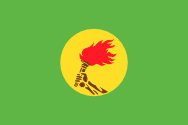Forces Armées Zaïrois
Forces Armées Zaïrois (Armed Forces of Zaïre, abbreviated FAZ), is the name of Zaïre's military forces. It consists of the Army, Navy, Air Force, and various intelligence and secret police and law enforcement and paramilitary organizations.
Contents
Army
The 22,000-member army consists of one infantry division (with three infantry brigades); one airborne brigade (with three parachute battalions and one support battalion); one special forces (commando/counterinsurgency) brigade; one DSI division; one independent armored brigade; and two independent infantry brigades (each with three infantry battalions, one support battalion). DSI stands for Division Spéciale Impériale (Special Imperial Division). They are the elite forces responsible for the protection of the President, his family, friends, and political allies, and his estates. They are the best-equipped, best-paid, and best-trained forces in the entire military. Trained by Israeli advisors, they are ruthlessly efficient. They are among the only military forces paid regularly, and nearly all members are recruited from the President's tribe and region. There are a total of around 5,000 DSI soldiers, or 1/5 of the Army. The top unit of the DSI are Les Hiboux (the Owls), the ones responsible for his personal safety. With the exception of the DSI, most army units are rarely paid (and their wages are abysmally low), poorly trained, poorly led, and of very low morale. In order to survive, they often prey on the helpless civilian population, by setting up roadblocks and demanding tolls in order for people to pass, confiscating farmers' produce on the way to the market, etc. Ironically, although the army's purported role is to protect the civilian populace, they do exactly the opposite, and they are almost universally feared and hated.
Major Army Equipment
Main battle tanks
- T-62 medium x40
- T-59 medium x20
- M-60 medium x10
- AMX-13 light1 x13
Armored reconnaissance vehicles
- AML-60 Panhard x30
- AML-90 x30
- FERRET x28
Armored personnel carriers
- M-113A x12
- M-3A1 x60
- YW-531 x12
- K-63 x12
- BTR-60 x15
- BTR-152 x250
- VAB1 x12
Towed artillery
- 75mm: M-116 x30
- 85mm: T-56 x20
- 122mm: M-1938/D-30 x20
- T-60 x15
- 130mm: T-59 x8
Multiple rocket launchers
- 107mm: T-63 x20
- 122mm: BM-21 x10
- 120mm: Brandt x50
Antiaircraft guns
- 37mm: M-1939/Type 63 x40
The navy has a total of 1,300 members, of which 600 are marines. Because Zaïre's Atlantic coast is only about forty kilometers long, Lake Tanganyika is the largest body of water that the navy patrols, so the navy's primary mission is to control illegal entry into the country. The navy also patrols rivers and other lakes, and conducts anti-smuggling patrols. The navy has bases in the following places: Banana, Boma, Matadi, Kinshasa, and Kalemie, (on Lake Tanganyika).
Fast patrol craft (inshore)
- Shanghai II PFI x2
- Huchuan x4
Torpedo boats
- P-4 x3
Coastal patrol craft
- Swift MkII x2
- Arcoa x18
Air Force
Comprised of approximately 1,800 members, the air force's primary purpose are air support, aerial reconnaissance, transporting units of the army and navy, and providing logistical support for other branches of the military. Because of poor maintenance, lack of spare parts, insufficient funding, and minimal training, the effectiveness of the air force's effectiveness is negligible at best. Many pilots are involved in black marketeering. Others operate their own (illegal) commercial airlines, costing the national airline millions every year. It is estimated that at least 75% of the air force's aircraft are non-deployable.
Major Air Force Equipment
Ground attack fighters
- Mirage 5M x7
- Mirage 5DM7 x1
Counterinsurgency aircraft
- MB-326 GB x8
- MB-326 K x6
- AT-6G United States x6
- FTB-337 Cessna x20
Transport aircraft
- Boeing 707-320 x1
- Boeing 727-30 x1
- BN-2A Islander x1
- C-46 Commando x2
- C-47 Dakota x8
- C-130H Hercules x5
- DHC-5D Buffalo x3
- DHC-6 Twin Otter x1
- C-54 Skymaster x4
- DC-6 x2
- MU-2J x2
- Merlin III x1
- Mystère-Falcon 20 x1
- F-27 Friendship x3
Helicopters
- AS-332L Super Puma x1
- SA-319 Alouette x4
- SA-330 Puma x4
- SA-321 Super Frelon x1
- Bell 47G x6
Liaison aircraft
- Cessna 310R x6
Training aircraft
- Cessna 150 x12
- Cessna 310 x3
- SF-260MC MZ Warrior x9
Intelligence & secret police
In addition to the secret police, there are two intelligence branches; all three of them report directly to the President. Aside from national security, their primary goal is curtailing, harassing, and suppressing dissent and anti-government activities. Each branch operates its own prisons, detention centers, and torture facilities. The branches are as follows:
- Agence Nationale de Documentation (AND), the secret police
- Service National d'Intelligence et de Protection (SNIP), the national intelligence network
- Service d'Action et de Renseignements Militaire (SARM), the intelligence arm of the Army
Law enforcement and paramilitaries
Law enforcement forces are comprised of local police; the Garde Civile (Civil Guard), who are responsible for normal civilian police duties, plus customs and border patrol; and the feared Gendarmerie Nationale, who have arranged for the "disappearance" of countless enemies of the state. The Gendarmerie Nationale is divided into two branches, the Gendarmerie Territoriale (police component) and the Gendarmerie Mobile (paramilitary organization). The Gendarmerie Nationale has a total of 25,000 members.

|
Royaume de Zaïre | 
|
|---|---|---|
| Main article: Zaïre | ||
| Government: Léopold Honoré Mobutu, Victor Ngbanda, Mouvement Populaire de la Révolution | ||
| Military: Forces Armées Zaïrois | ||
| Corporations: Gécamines, MIBA, TriPetal (article by Laurasia) | ||
